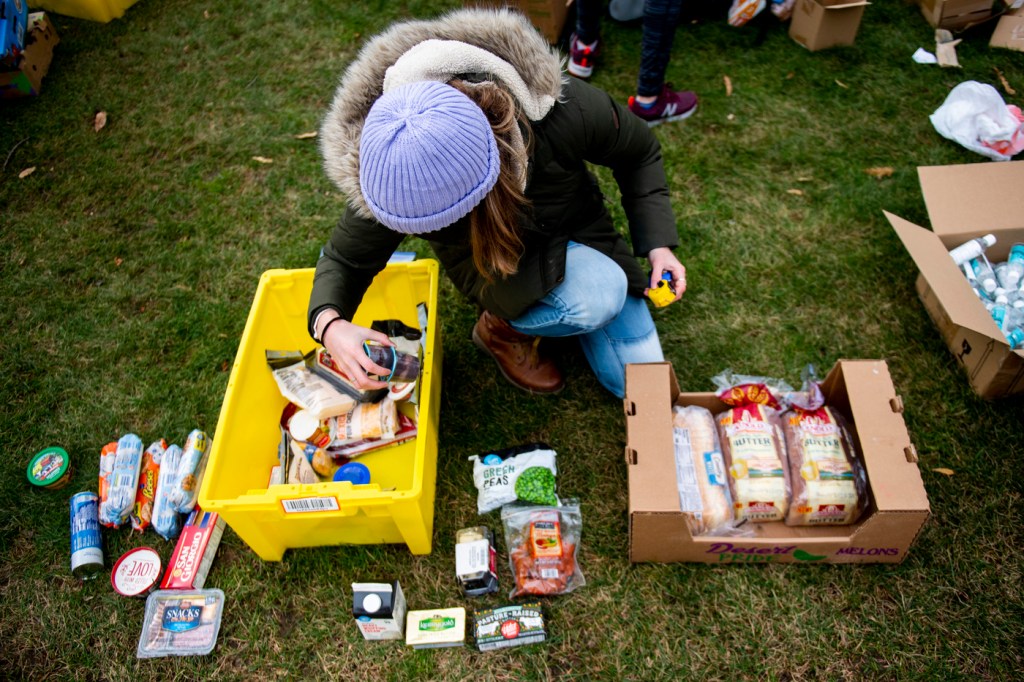Supermarkets help their bottom line when they donate to food banks

Scroll through any supermarket chain’s social media feed and you’re bound to see feel-good stories about charitable food donations to the community. What may seem like an altruistic gesture at first sight is actually helping the company’s bottom line, according to research by a Northeastern professor who studies food waste.
Corporate food giants such as Kroger and Walmart traditionally operate on slim margins, meaning their profits are a small fraction of revenue, so they try to drive revenue or take steps to save money any way they can, says John Lowrey, an assistant professor in both the D’Amore-McKim School of Business and Bouvé College of Health Sciences.
One key source of that revenue? Charging shoppers up to 33% more for blemish-free perishables such as fruits, vegetables, and meat, Lowrey’s research found.

‘Do you price the banana with four brown spots lower than one with 10 brown spots?’ asks food waste expert John Lowrey. He holds a joint appointment in the D’Amore-McKim School of Business and Bouvé College of Health Sciences.
Here’s how it works. Some chains send still-edible, but otherwise unsaleable products, to the food bank; those that do not donate keep the blemished product on shelves longer in search of a sale. Retail donations serve the food bank’s mission to help alleviate hunger, but may also have real implications for retailers’ inventory management practices.
Lowrey explains that retailers are somewhat constrained by the lack of available options for their unsaleable food. One option is to mark down the product, a practice more commonly referred to as “dynamic pricing.” For perishable categories like produce, dairy, bakery, and meat, as the food degrades in quality, a retail store may decide to mark it down in price to increase the chance of a sale.
Yet, this is not a perfect solution, as dynamic pricing and quality-grading perishable food is a very labor-intensive activity.
Furthermore, unlike surge pricing on the Uber app, it is difficult to instantaneously observe supply and demand for food, which makes pricing more challenging. “Any store associate tasked with culling and pricing bananas, for example, will struggle to answer the question, ‘How do I price the banana with four brown spots relative to the one with eight or nine brown spots?’,” Lowrey says.
Marking down the product to sell at a lower price may still provide some revenue so long as the product actually sells. Otherwise, low-quality markdown items compete for the same shelf space as high-quality, fresh items.
As an alternative to marking down food, a retailer can remove it from the shelf while it still looks good, donate it to the food bank, and replace the newly available shelf space with higher-priced, fresher items.
In other words, a store that actively donates food is less likely to have low-quality items on the shelf. Keeping more fresh items on display means that the food that they do sell fetches a higher average price and results in a higher margin.
“This remove-and-replace effect offers the dual benefit of reducing the handling and outdating costs of degrading produce and increasing the average quality of food that remains on-shelf. Higher quality means higher prices,” says Lowrey.
Removing low-quality, unsaleable products from the shelf early and handing it off to the food bank also directly offsets waste removal costs, which can be high. Yet, the benefit of food donations extends well beyond an opportunity to reduce the cost of waste to include, as the research shows, an in-store pricing and margin benefit.
Food donations are not just charitable gestures by big supermarket chains, but are also in their financial self-interests.
In the D’Amore-McKim School of Business, Lowrey’s research focuses on the competitive effects of food donations on retail practices. In his joint appointment in the Bouvé College of Health Sciences, he examines the preventative health benefits of food donations for patients with diet-based, chronic diseases.
The Columbus, Ohio, native first got interested in the subject working with the Mid-Ohio Food Collective, the largest food bank in Ohio.
Around 2016, he was intrigued by the lack of options for food waste and the resulting critical role of the retail donor, as a supplier, to food banks across the nation.
“I was shocked by the sheer volume of food that food banks were collecting from these big retail stores, and it just got my attention,” Lowrey says. That eventually led to his present research.
“I found that these retail stores—Kroger and Walmart and Sam’s Club, among others—are effectively sustaining this whole secondary market for food, wherein food banks recover, repurpose, and redistribute food to feed the hungry.”
It’s the retailers’ food that is providing sustenance for an ever-growing population of food-insecure people, which may confer a public-health benefit, he adds. “This is the health-focused side of my research,” Lowrey says.
More than 38 million people, including 12 million children, in the United States don’t have enough to eat, according to the U.S. Department of Agriculture, which oversees the country’s food-stamp program.
Food banks form an important, yet overlooked, part of the food supply chain, Lowrey’s research shows. Donating perishable food that is past its prime allows big food chains to maintain better-looking items on the shelf, resulting in higher prices and larger markups than would otherwise be the case.
“For a food retailer, you never, ever want to miss a sale, especially one for a fresh, high-quality perishable item,” Lowrey says.
For media inquiries, please contact media@northeastern.edu.